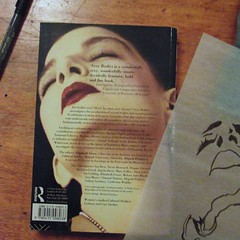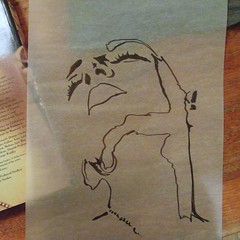
A few years ago I wanted a vintage-looking silk-screened t-shirt with a high-contrast face on it. I do know how to silk screen (courtesy of my print-maker mom), but I don't have silk frames in my tiny tiny apartment, nor do I have all the various chemicals, the funky-smelling greasy ink, the squeegees, the ninety miles of cat-free horizontal space to lay out the drying prints, etc. So, I came up with a way to make something that looks like it was silk-screened, but only involves a tiny tub of fabric paint, one shirt, and a paint brush.
You will need:
Tracing paper
Pencil
A photograph of something you want on the T-shirt, at the size you want it
An x-acto knife
A smallish paint brush
Opaque fabric paint (I like Setacolor or Tulip brand)
Tape
Cardboard
How to do it:
First, I need to explain a few things about the materials, because several variables are quite important. You must use real tracing paper, not a substitute. I tried this once with vellum, and it was a disaster. You should also look for the most viscous paint available. The thicker and goopier it is, the better it will maintain the shape of your stencil and the more opaque it will look. Think about the color of the paint vs the color of the shirt. Darker paints on lighter fabrics are easier to deal with. If you have really really opaque paint, you can do light paint on dark fabric, but this is more likely to come out uneven and blobby. Finally, think about image size, shirt stretchiness, and where the image will end up on your chest. If the shirt is very stretchy and tight, and the image is right over your boobs, the whole thing is going to get stretched way out of shape.

1. Ok, find an appropriate image you want to transfer to your shirt. Several qualities are important that you might not think of right off the bat. The image should be contrasty - i.e. lots of very light areas and very dark areas, but not much in the middle range. This will make it much easier to make a comprehensible stencil out of it. The image should be fairly iconic, meaning a recognizable object. For example, a human face is very recognizable as a human face, even if sketchily drawn. An old rotary telephone is recognizable. An example of something that is NOT recognizable is a high-contrast photo of a Vietnamese pot-bellied pig. Yes, I tried this once, and the image on the shirt looks nothing like a pig and a great deal like Lenin.

WRONG!!
2. If you found your picture on the internet, blow it up or shrink it down to the size of what you want on the shirt and print it out. If you are using books or magazines, look for something that is already the right size.
3. Put your tracing paper over the image and tack it down with a little tape to keep it from moving.
4. Now, trace your image. Don't use lines. Instead, color in only the dark areas with solid black and leave everything else alone. This process can be aided by using a thick, dark marker (like a bold sharpie). You are going to be cutting out the dark areas later, so don't make them too tiny or intricate.

5. Next, check to make sure your dark blobs make a recognizable image. Take the tracing paper off the image and put a white piece of paper behind it. Ask yourself, "if I hadn't just been staring at this for half an hour, would I know what it was?" If the answer is yes, proceed. If not, start over, probably with a different image.
6. Now cut out all of your little blobs with your x-acto knife. This takes a while. Make sure you have a couple of new blades around. A dull knife will rip your paper.
7. Tape the tracing paper stencil to the shirt. You want everything very flat at this point. I usually put a big piece of cardboard inside the shirt to give myself a flat surface. Just make sure that the shirt doesn't have to stretch to go around the cardboard.
8. Prep your painting tools. The fabric paint I recommend cleans up with water, so get two small containers of water, one for cleaning your brush, one for cleaning up potential mistakes on the shirt. Also get a clean rag and a few clean pieces of paper towel.
9. Paint over your stencil. Make sure that you are careful not to stick the brush under the edges of the tracing paper - it should stay flat down on the shirt. This is why you must use tracing paper and not something like vellum or plain paper, the tracing paper tends not to absorb the water, so it doesn't wrinkle or curl up. Be sure to apply the paint evenly.

10. When you are finished, carefully remove the tape and peel back the stencil. The stencil can be saved for future use on other shirts. Put the shirt somewhere to dry where your pets won't use it as a racetrack. When it's dry (this usually takes at least 8 hours), turn it inside out and iron it with a hot iron to set the ink.
Hey presto, it's a shirt with a thing on it!

2 comments:
I love the t-shirts you made when you were figuring this out. I especially love that even having read the directions, which are very clear, I know that I couldn't draw well enough to make a stencil that looks half as cool as yours.
don't feel _too_ awed, b. the pig shirt was a hilarious disaster.
Post a Comment